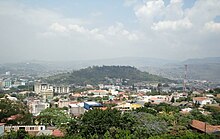Economy of Honduras

|
|
| Currency | Honduran Lempira (HNL) |
|---|---|
| Calendar year | |
|
Trade organizations
|
DR-CAFTA, WTO |
| Statistics | |
| Population | 8.098 million (2013 est.) |
| GDP | $18.55 billion (2013) |
| GDP rank | 107th (nominal) / 104th (PPP) |
|
GDP growth
|
3.3% (2012 est.) |
|
GDP per capita
|
$4,700 (PPP; 2012) |
|
GDP by sector
|
agriculture: 13.9%, industry: 27.7%, services: 58.4% (2012 est.) |
| 5.2% (2012 est.) | |
|
Population below poverty line
|
60% (2010 est.) |
| 57.7 (2007) | |
|
Labor force
|
3.44 million (2012 est.) |
|
Labor force by occupation
|
agriculture: 39.2%, industry: 20.9%, services: 39.8% (2005 est.) |
| Unemployment | 4.4% (2012 est.) |
|
Main industries
|
sugar, coffee, woven and knit apparel, wood products, cigars |
| 105th (2017) | |
| External | |
| Exports | $7.9 billion (2012 est.) |
|
Export goods
|
apparel, coffee, shrimp, automobile wire harnesses, cigars, bananas, gold, palm oil, fruit, lobster |
|
Main export partners
|
|
| Imports | $11.2 billion (2012 est.) |
|
Import goods
|
machinery and transport equipment, industrial raw materials, chemical products, fuels, foodstuffs |
|
Main import partners
|
|
|
Gross external debt
|
$5.2 billion (31 December 2012 est.) |
| Public finances | |
| 35.8% of GDP (2012 est.) | |
| Revenues | $3.1 billion |
| Expenses | $4.2 billion (2012 est.) |
| B (Domestic) B (Foreign) B+ (T&C Assessment) (Standard & Poor's) |
|
|
Foreign reserves
|
$2.5 billion (31 December 2011 est.) |
The economy of Honduras is based mostly on agriculture, which accounts for 14% of its gross domestic product (GDP) in 2013. Leading export coffee ($340 million) accounted for 22% of total Honduran export revenues. Bananas, formerly the country's second-largest export until being virtually wiped out by 1998's Hurricane Mitch, recovered in 2000 to 57% of pre-Mitch levels. Cultivated shrimp is another important export sector. Since the late 1970s, towns in the north began industrial production through maquiladoras, especially in San Pedro Sula and Puerto Cortés.
Honduras has extensive forests, marine, and mineral resources, although widespread slash and burn agricultural methods continue to destroy Honduran forests. The Honduran economy grew 4.8% in 2000, recovering from the Mitch-induced recession (-1.9%) of 1999. The Honduran maquiladora sector, the third-largest in the world, continued its strong performance in 2000, providing employment to over 120,000 and generating more than $528 million in foreign exchange for the country. Inflation, as measured by the consumer price index, was 10.1% in 2000, down slightly from the 10.9% recorded in 1999. The country's international reserve position continued to be strong in 2000, at slightly over $1 billion. Remittances from Hondurans living abroad (mostly in the U.S.) rose 28% to $410 million in 2000. The Lempira (currency) was devaluing for many years but stabilized at L19 to the US dollar in 2005. The Honduran people are among the poorest in Latin America; Gross national income per capita (2007) is $US 1,649; the average for Central America is $US 6,736. Honduras is the fourth poorest country in the Western Hemisphere; only Haiti, Nicaragua, and Guyana are poorer. Utilizing alternative statistical measurements in addition to the Gross Domestic Product can provide greater context for the nation's poverty.
...
Wikipedia
